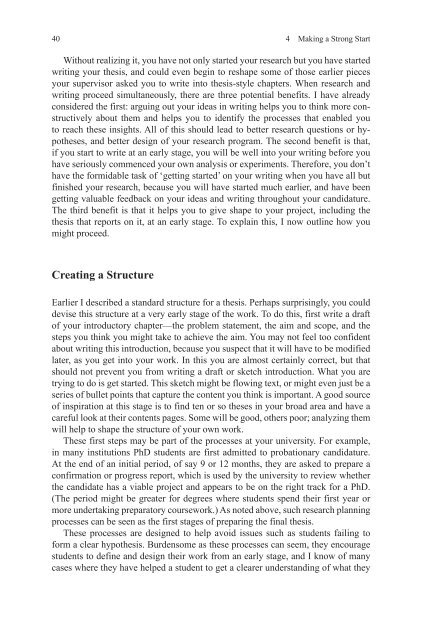How-to-Write-a-Better-Thesis
You also want an ePaper? Increase the reach of your titles
YUMPU automatically turns print PDFs into web optimized ePapers that Google loves.
40 4 Making a Strong Start<br />
Without realizing it, you have not only started your research but you have started<br />
writing your thesis, and could even begin <strong>to</strong> reshape some of those earlier pieces<br />
your supervisor asked you <strong>to</strong> write in<strong>to</strong> thesis-style chapters. When research and<br />
writing proceed simultaneously, there are three potential benefits. I have already<br />
considered the first: arguing out your ideas in writing helps you <strong>to</strong> think more constructively<br />
about them and helps you <strong>to</strong> identify the processes that enabled you<br />
<strong>to</strong> reach these insights. All of this should lead <strong>to</strong> better research questions or hypotheses,<br />
and better design of your research program. The second benefit is that,<br />
if you start <strong>to</strong> write at an early stage, you will be well in<strong>to</strong> your writing before you<br />
have seriously commenced your own analysis or experiments. Therefore, you don’t<br />
have the formidable task of ‘getting started’ on your writing when you have all but<br />
finished your research, because you will have started much earlier, and have been<br />
getting valuable feedback on your ideas and writing throughout your candidature.<br />
The third benefit is that it helps you <strong>to</strong> give shape <strong>to</strong> your project, including the<br />
thesis that reports on it, at an early stage. To explain this, I now outline how you<br />
might proceed.<br />
Creating a Structure<br />
Earlier I described a standard structure for a thesis. Perhaps surprisingly, you could<br />
devise this structure at a very early stage of the work. To do this, first write a draft<br />
of your introduc<strong>to</strong>ry chapter—the problem statement, the aim and scope, and the<br />
steps you think you might take <strong>to</strong> achieve the aim. You may not feel <strong>to</strong>o confident<br />
about writing this introduction, because you suspect that it will have <strong>to</strong> be modified<br />
later, as you get in<strong>to</strong> your work. In this you are almost certainly correct, but that<br />
should not prevent you from writing a draft or sketch introduction. What you are<br />
trying <strong>to</strong> do is get started. This sketch might be flowing text, or might even just be a<br />
series of bullet points that capture the content you think is important. A good source<br />
of inspiration at this stage is <strong>to</strong> find ten or so theses in your broad area and have a<br />
careful look at their contents pages. Some will be good, others poor; analyzing them<br />
will help <strong>to</strong> shape the structure of your own work.<br />
These first steps may be part of the processes at your university. For example,<br />
in many institutions PhD students are first admitted <strong>to</strong> probationary candidature.<br />
At the end of an initial period, of say 9 or 12 months, they are asked <strong>to</strong> prepare a<br />
confirmation or progress report, which is used by the university <strong>to</strong> review whether<br />
the candidate has a viable project and appears <strong>to</strong> be on the right track for a PhD.<br />
(The period might be greater for degrees where students spend their first year or<br />
more undertaking prepara<strong>to</strong>ry coursework.) As noted above, such research planning<br />
processes can be seen as the first stages of preparing the final thesis.<br />
These processes are designed <strong>to</strong> help avoid issues such as students failing <strong>to</strong><br />
form a clear hypothesis. Burdensome as these processes can seem, they encourage<br />
students <strong>to</strong> define and design their work from an early stage, and I know of many<br />
cases where they have helped a student <strong>to</strong> get a clearer understanding of what they














![[Lonely Planet] Sri Lanka](https://img.yumpu.com/59845622/1/169x260/lonely-planet-sri-lanka.jpg?quality=85)


